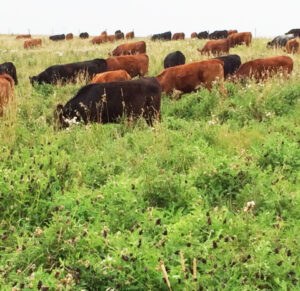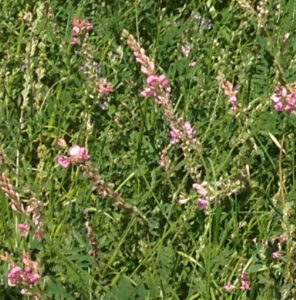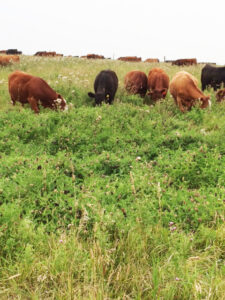Let Cattle Do the Seeding
Cattle can be managed to produce calves, beef and milk, but can they also be put to work re-seeding pastures?

As long as you’re not in a hurry, producers who manage beef cows and yearlings so they distribute legume seeds through their manure, say “yes” it can be a passive, yet effective means of establishing desirable forages on pasture.
There doesn’t appear to be a handy term to describe this re-seeding technique, and on many farms and ranches with late season grazing it probably happens naturally anyway.
But several Alberta producers who see a benefit, are making a point to manage pastures so cattle are consuming mature forage seeds, in hopes at least some are shed in manure and germinate to establish the species on other parts of the pasture. And from their observations over the past few years, it works.
Ian Murray, who owns Shoestring Ranch at Acme, northeast of Calgary, says over the past three years he is seeing more desirable grazing species such as cicer milk vetch on areas of his pasture where there were few or none before.

Alex Robertson who ranches at Longview, south of Calgary says he is seeing more legumes on his tame pastures. And Graeme Finn, who ranches with family members at Crossfield, just north of Calgary, says while he believes in the practice of distributing seed through late-season grazing, he’s also taken it a step further. Finn adds a “bean can full” of raw seed to each bag of mineral mix in hopes of getting more seed established on pasture, without having to pull out the seed drill.
Long-time Alberta Agriculture grazing and forage specialist Grant Lastiwka says the concept makes sense — let some pasture mature and set seed before grazing, in hopes of distributing more seed in manure. He does have some caveats to feeding extra seed through the mineral mix.
Legumes are well suited
This manure/seeding technique is best suited for hard-coated forage seed such as legumes, say ranchers and specialists alike. Alfalfa, clovers, sainfoin, trefoil and cicer milk vetch all produce hard-coated seed and many can pass through an animal’s digestive system without being damaged. Grass seeds such as brome and orchard grass seed are typically softer seeds and can be damaged in the rumen.
Cicer milk vetch is one legume that is targeted for the manure/seeding technique. It’s a high yielding, palatable, high protein legume, that is also a prolific seed producer. It is a bloat-resistant legume that works well in a grazing system.
Ian Murray says he definitely sees improved distribution of cicer milk vetch since he has focused on the program.
“No doubt there has been some of this happening all along, but I have made a conscious effort to stockpile pastures for seed distribution since 2014,” says Murray.
Legume inoculants: Legumes can germinate and grow without inoculants, but they cannot fix nitrogen into the soil unless they are inoculated with the right bacteria. Some soils contain natural bacteria that can inoculate the legume roots and promote nitrogen fixation. Effective inoculation and nitrogen fixation will be most likely to occur in pastures that already contain some established legumes whose roots have nodules that are well-developed and pink or reddish inside.
Murray runs a 180 head cow-calf and yearling operation that grazes nearly 12 months a year. He moves cattle through about 40 different paddocks, ranging from 20 to 45 acres, during the year. Most of the long-established pastures on his ranch are grass based with varying degrees of cicer milk vetch mixed in. He would like to see more.
“For example, we had a quarter section that was cross fenced into paddocks,” he says. “The south end of the quarter had more cicer milk vetch than the north end. So we make a point of letting some of the paddocks mature and go to seed, then we can let the cattle in to fall graze — they take seed with them, as they move through other paddocks.”
Research shows it can take up to three days for feed eaten today, to completely move through a cow’s digestive system. So as animals move, the seed moves too.
Murray says he had a better look at some of the manure patties last year after a big rain and “there are hundreds of seeds” in the manure. He’s not sure how many of those seeds will germinate and grow, but even some is good.
“And I believe it is working,” he says. “We are starting to see more cicer milk vetch in areas where we didn’t have that much, so it is being moved around.” While grass seeds may not survive a trip through the cow’s digestive system, allowing the plants to mature on mixed stand pastures provides an opportunity for them to drop seed and fill in the pasture around them.

“I look at a pasture as permanent resource,” says Murray. “So if we can fill in, and distribute these grasses and legumes so they keep re-establishing themselves then these really become permanent pastures that won’t have to be re-seeded.”
Alex Robertson is seeing a similar response on his southern Alberta ranch. His pastures include grasses such as orchard grass, meadow brome and tall fescue, along with cicer milk vetch, sainfoin, birdsfoot trefoil and some alfalfa.
“Unintentionally there has been some re-seeding by the cows for about 20 years,” he says. “But for the past five years we have been changing pasture management to encourage more re-seeding.”
His cattle are out on native grass range for most of the winter and move onto stockpiled tame forage in April and May. “We start calving in later spring and as soon as the cow-calf pairs are mothered up we move them out to this stockpiled pasture, which has gone to seed, and there is also some new growth coming underneath,” he says.
As cows eat that stockpiled forage, seed is distributed over the pasture. “I am seeing more of the legumes, such as cicer milk vetch, appearing in different parts of our pastures,” he says. “I don’t know if it will ever build to where we have more grass, but hopefully it will at least maintain these stands as productive pastures.”
Works in bush land as well
Graeme Finn says he is seeing some of these desirable legumes such as cicer milk vetch, sainfoin and clovers beginning to establish themselves on land that has been annually cropped for 30 years. “Our cattle will move from paddocks with stockpiled forage onto fields where annual crops have been cut for swath grazing, and now we are starting to see these legumes on the swath grazed fields.”
While Finn stockpiles forage so cattle can fall graze and move seeds in manure, he also feeds raw seed to cattle throughout the year as well. Anytime a mineral box is being refilled he mixes in one or two “bean cans” of sainfoin, cicer milk vetch and alfalfa seed with the mineral (it probably works out to about one pound of seed per bag of mineral.)
“We do this summer and winter, with cows, yearlings and bulls and we are starting to see these legumes popping up all over,” says Finn. The system works well on open pasture and especially well in bush land, where tillage or mechanical seeding wouldn’t be an option anyway.
“We’ve been doing this for a while and last year I went out with the quad to spray some thistle and toadflax in one bush area and I had to quit,” says Finn. “There was so much sainfoin coming in among the grass I stopped because I didn’t want to spray it out. Driving by you might not notice, but when you stop and look the legumes are coming.”

Finn estimates he uses about two bags of seed (about $300 per bag) for each pallet of mineral.
He along with Lastikwa make the point if seed is going to be actually fed to cattle, it needs to be raw seed, untreated and with no mechanical injury or scarification from harvest.
“It needs to be raw, undamaged seed,” says Lastikwa. He says salt and some other minerals could potentially damage the seed coat as well. He’s not sure how many ranchers will actually “feed” seed to cattle, but he says there is nothing wrong with cattle harvesting mature legume stands on their own.
“Research shows these hard seeds will pass through the animal and can establish themselves on pasture,” says Lastikwa.
He says “planning” to have cattle distribute seed is all part of a well-managed grazing system.
“If you look at the whole picture, a well managed grazing system that allows for a longer grazing season, is good economics as it can help reduce winter feeding costs,” he says. “And generally as you develop that type of system, you’re going to have some pastures that get mature and go to seed. So its really the point where management for a highly productive and healthy forage stand and longer season of grazing come together.”
Lastikwa says manure/seeding isn’t a fast way to establish plants and renew a pasture, but at the same time it is a low or no-cost reseeding system, too. “It’s a slow process and we don’t know how many seeds in that fecal deposit will germinate and sometimes they can be quite a distance apart. But over time these legumes can be distributed and pastures renew over the long haul.”
Click here to subscribe to the BCRC Blog and receive email notifications when new content is posted.
The sharing or reprinting of BCRC Blog articles is welcome and encouraged. Please provide acknowledgement to the Beef Cattle Research Council, list the website address, www.BeefResearch.ca, and let us know you chose to share the article by emailing us at info@beefresearch.ca.
We welcome your questions, comments and suggestions. Contact us directly or generate public discussion by posting your thoughts below.